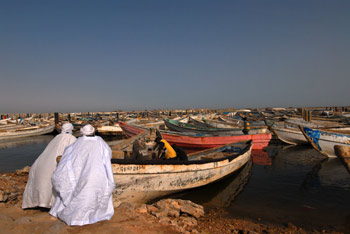West Africa — Who’s Next?
by Jon Keller
|
Imagine this: You are a fisherman on the other side of the Atlantic, on the coast of West Africa. You are telling your family that you no longer have a job, that you cannot eat because people in foreign countries that speak strange languages want the fish more than you, and they can have the fish because they have more money than you do. These people can buy your fishing grounds because your government needs money. So you load your family into a crowded boat and cross the sea in search of work.
Just north of the West African coast lies Europe, the world’s largest importer of seafood—a market worth over $20.6 million a year. Sixty percent of that is imported, and half of those imports come from developing nations, such as those found in West Africa.
Until recently, Africa’s Atlantic coast held strong stocks of tuna, shrimp, sardines, salmon, anchovies, hake, octopus, conch, lobster; and more exotic fish like parrotfish, doctorfish and butterfish. This thriving fishery, combined with the poverty of West Africa’s shores, proved to be an ideal solution for fish-hungry Europe.
The economic and social distress of the developing nations like Senegal, Morocco, Mauritania and Guinea-Bissau meant the governments were more than willing to sell their fishing rights to the affluent EU and other large nations, such as Russia and China.
The first fisheries deal between the EU and West Africa came in 1979 (previous to that, the fishing went unregulated). Since then, things have only escalated. By 1991, the United Nations had stepped in and negotiated a treaty that gave local governments the right to sell the fishing rights for surplus stocks only.
continue
|

The harbor in Nouadhibou, Mauritania on Tuesday June 19, 2007. Mauritania is a poor, mostly desert country which relies on fishing as one of its main industries. Competition between European trawlers and Mauritanian fishermen is an increasing problem. The combination of engineering, capital and politics is driving fisheries around the world to an end that has arrived in West Africa. Candace Feit photo/candace.feit@gmail.com |
|
|
|
|
Boatbuilders Downeast
by Brenda Tredwell
|
Galen Alley’s LORNA R. sits outside his shop as his crew inside works on a new fiberglass version — almost identical to the original wooden LORNA R. — which he’ll race this season. A make-shift work bench sits where there are usually bait barrels. Galen’s crew has a job ahead of them, finishing work required before a custom engine is installed, and sea-trials can be run. After that comes the fine-tuning.
Because these guys know that, the stock answer to “When’ll she be done?” is “June 12th!”—in Boothbay.
“We brought her in upside down,” says Galen of the fiberglass hull pulled from the wooden boat built by Dick Alley with Riley Beal in 1973. “Libby and his boys are the ones who done it, over in Ernest’s shop,” continues Galen. “They Poly-faired the hull, sanded it down — laid her up on one side, waxed the hull, glassed it, then did the same on the other side. A center board ran along the keel —the mold came right off in two pieces. To lay up the LORNA R., they bolted on a flange—tied up the two halves outside the shop.” Using the LORNA R as a plug, Libby’s crew made the female mold which they rolled with gel-coat to prep it.
continue
|
| Richard Weaver in his Steuben shop with the engine he is building for Galen Alley in the foreground. The engine will power the new fiberglass Lorna R that Earnest Libby Jr. has been working on. Brenda Tredwell photo |
|
|

